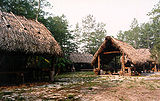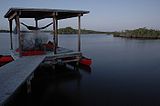
Chickee
Encyclopedia

Palmetto
-Botany:Members of several genera of small palms:*the genus Sabal of the Arecaceae family**Dwarf Palmetto**Sabal palmetto*Saw Palmetto, Serenoa repens*Silver saw palmetto, Acoelorraphe wrightii-Place names:United States...
thatch
Thatching
Thatching is the craft of building a roof with dry vegetation such as straw, water reed, sedge , rushes, or heather, layering the vegetation so as to shed water away from the inner roof. It is a very old roofing method and has been used in both tropical and temperate climates...
over a bald cypress log frame — was adopted by Seminoles during the Second
Second Seminole War
The Second Seminole War, also known as the Florida War, was a conflict from 1835 to 1842 in Florida between various groups of Native Americans collectively known as Seminoles and the United States, part of a series of conflicts called the Seminole Wars...
and Third Seminole War as U.S. troops pushed them deeper into the Everglades and surrounding territory. Before the Second Seminole War, the Seminoles had lived in log cabins. Similar structures were used by the tribes in south Florida when the Spanish first arrived in the 16th century. Each chickee had its own purpose and together they were organized within a camp-type community. Chickees were used for cooking, sleeping, and eating.
Modern use

Miccosukee
The Miccosukee Tribe of Indians of Florida are a federally recognized Native American tribe in the U.S. state of Florida. They were part of the Seminole nation until the mid-20th century, when they organized as an independent tribe, receiving federal recognition in 1962...
in the Everglades. Some upscale homes in southern Florida feature chickee-inspired buildings as garden or poolside structures. A few restaurants in Florida still use this unique design to attract visitors.
Chickees are also used in backcountry areas of Everglades National Park
Everglades National Park
Everglades National Park is a national park in the U.S. state of Florida that protects the southern 25 percent of the original Everglades. It is the largest subtropical wilderness in the United States, and is visited on average by one million people each year. It is the third-largest...
where mangroves or large bodies of water prevent camping on dry land. Made and maintained primarily for backcountry campers, these wooden structures stand several feet above the water and can usually accommodate four to five campers. These structures have portable restrooms. Some "double chickees" are linked by a walkway and can accommodate eight to ten people.
There are about eight to ten chickees in one village. Chickees are very helpful, especially in the rain. Similar structures, while not referred to as chickees, are present further north, in the Okefenokee National Wildlife Refuge
Okefenokee National Wildlife Refuge
The Okefenokee National Wildlife Refuge is a 402,000 acre National Wildlife Refuge located in Charlton, Ware, and Clinch Counties of Georgia, and Baker County in Florida, United States. The refuge is administered from offices in Folkston, Georgia. The refuge was established in 1937 to protect...
in southern Georgia.They are made from buffalo hides.
Connection with Mesoamerica
The Muskogean spelling for chickee is "chiki." Among Creeks and Seminoles speaking the Hitchiti language, chiki is today the generic word for "house." Chiki is also the word for house among the Totonacs of Mexico. However, Creeks, who speak the Muskogee language, use chiki only to describe a summer house or open-sided residence typical of Florida. Muskogees use the word "chuko" or "choko" to describe a house with solid walls, suitable for occupancy in cold weather. "Choko" is the Puntun and Itza Maya word for "warm" or "hot."Totonac chiki's are residential structures consisting of prefabricated wood frames that are encased with adobe or concrete after being erected and tied together. This same type of prefabricated house, called "post ditch construction" by archaeologists in the United States, first appeared in what is now Georgia around 750 AD and became commonplace after the founding of a settlement around 900 AD, now known as Ocmulgee National Monument in Macon, Georgia. The use of post ditch construction spread outward from Ocmulgee to other areas of the southeastern United States. By 1050 AD, most houses at the large indigenous community now called Cahokia, Illinois were of post ditch construction.
It is likely that the word chiki originally applied only to prefabricated houses and over time came to generically mean "house" among Hitchiti-speaking Creek Indians. When some Creek towns moved southward into Florida during the 18th century, they used the same word to describe lightly framed houses suitable for a semi-tropical climate.

